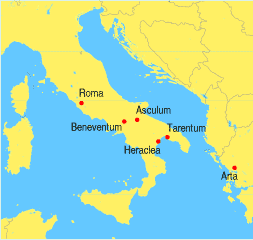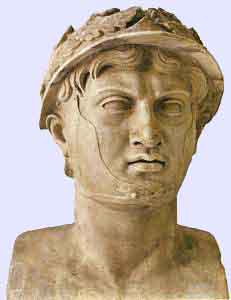.
 Most important places in the Pyrrhic War |
|||||||||||||||||||||||||||||||
|---|---|---|---|---|---|---|---|---|---|---|---|---|---|---|---|---|---|---|---|---|---|---|---|---|---|---|---|---|---|---|---|
|
Battle of Heraclea |
|||||||||||||||||||||||||||||||
|
Conflict |
Roman-Epiriotic conflict |
||||||||||||||||||||||||||||||
|
Date |
280 BC |
||||||||||||||||||||||||||||||
|
Place |
Heraclea, Basilicata, southern Italy |
||||||||||||||||||||||||||||||
|
Result |
Epirote victory (a "Pyrrhic victory") |
||||||||||||||||||||||||||||||
|
|||||||||||||||||||||||||||||||
The Battle of Heraclea took place in 280 BC between the Romans under the command of consul Publius Valerius Laevinus and the combined forces of Greeks from Taranto, Thurii, Metapont, Heraclea and Epirus under the command of king Pyrrhus of Epirus.
Background
Taranto was a Greek colony, part of Magna Graecia. The democrats in Taranto under Philocharis or Ainesias were against Rome, because they knew that if the Romans entered Taranto the Greeks would lose their independence. The Greeks in Taranto were afraid of Roman expansion after the third Samnite War. After the surrender of the Samnites in 290 the Romans founded many colonies in Apulia and Lucania, the most important of which was Venuzia.
In 282, after a battle against the Samnites, Lucanians, Bruttians and Thurioi, Roman garrisons entered Croton, Lokroi, and Rhegium. Democrats from Taranto knew that as soon as Rome finished its war with the Celts, Lucanians, Etruscans, Samnites, and Bruttians, they would enter Taranto.
The second faction in Taranto were the aristocrats, led by Agis, who did not oppose surrendering to Rome as it would increase his own power. The aristocrats did not want to surrender directly and become unpopular with the population, so they came up with another plan. In the autumn of 282 Taranto celebrated their festival of Dionysus; while in their theatre in front of sea, they saw 10 Roman ships with soldiers entering the Gulf of Taranto. In the opinion of Polish historian Krzysztof Kęciek the aristocracy asked the Roman commanders Publius Cornelius and Lucius Valerius to arrest and execute the democrats and their followers, which would allow the aristocrats to surrender. The democrats argued that the Romans had signed an agreement not to sail into the Gulf of Taranto, and they prepared the Tarantian navy to attacked the Roman ships. A quarter of the ships were sunk, and one was captured.
The democrats knew that had one more chance of victory against Rome. They decided to call for help Pyrrhus, king of Epirus. The army and fleet of Taranto moved to Thurioi and helped the democrats there exile the aristocrats. The Roman garrison placed in Thurioi withdrew.
Rome sent diplomats to Tarento but the talks were broken off by the Greeks. In 281 Roman legions under the command of Emilius Barbula entered Taranto and plundered it. Taranto, with Samnite and Sallentinian reinforcements, then lost a battle against the Romans. After the battle the Greeks chose Agis to sign a truce and begin diplomatic talks. These talks were also broken off when 3000 soldiers from Epirus under the command of Milon entered the town. The Roman consul withdrew and suffered losses from attacks by the Greek ships.
Pyrrhus decided to help Taranto because he was in debt to them - they had earlier helped him conquer the island of Corcyra. He also knew that he could count on help from the Samnites, Lucanians, Bruttians, and some Illyrian tribes. His ultimate goal was to capture Macedon, but did not have enough money to recruit soldiers. He planned to help Taranto, then go to Sicily and attack Carthage. After winning a war against Carthage and capturing south Italy he would have enough money to organise a strong army and capture Macedonia.
Preparation
Before he left Epirus, he borrowed some phalanxes from the Macedonian king, and demanded ships and money from the Syrian king and from Antigonus II Gonatas of Antioch. The Egyptian king also promised to send 9,000 soldiers and 50 elephants. These forces had to defend Epirus while Pyrrhus was gone. He recruited soldiers in Greece as well, as the Greek king wanted to avoid a war with Epirus, even though he was unconcerned with the Greeks in Italy. In the spring of 280 Pyrrhus landed without losses in Italy. He had 20,000 phalangites, 500 peltasts, 2,000 archers, 3,000 elite cavalry from Thessaly, and 20 war elephants.
After hearing of Pyrrhus' arrival in Italy the Romans mobilized eight legions with auxiliares, totalling about 80,000 soldiers. They divided it into four armies:
One army under the command of Barbula, with orders to distract the Samnites and Lucanians so they could not join Pyrrhus' army. They were placed in Venusia.
A second army left behind to secure Rome.
A third army under the command of consul Titus Coroncanius marched against Etruscans.
A fourth army under the command of Valerius Levinus marched to Taranto. They also plundered Lucania.
The battle
Pyrrhus didn't march against the Romans while he was waiting for his allies' reinforcements. When he understood that reinforcements were not coming, he decided to fight the Romans on a plain near the river Siris, between Pandosia and Heraclea. Pyrrhus took up position there and waited. Before the fight he sent diplomats to the Roman consul, proposing that he could arbitrate the conflicts between Rome and the population of south Italy. He promised that his allies recognised him as a judge and demanded the same from the Romans. The Romans denied his request, and entered the plains on the right of the Siris river where they set up camp.
It is unknown how many troops Pyrrhus had left in Taranto, but he probably had about 25-30 000 troops with him at Heraclea. He took up position on left bank of the Siris, hoping that the Romans would have difficulty crossing the river, which would allow him more time to prepare his attack. He set up some light infantry units near the river to let him know when the Romans began to cross, and planned first to attack them with his cavalry and elephants. Valerius Laevinus had about 30 000 soldiers under his command, including many cavalry, peltasts, and spearmen.
At dawn, the Romans started to cross the river Siris: the Roman cavalry attacked on the flanks the Greek scouts and light infantry, which were forced to flee.
When Pyrrhus learned that the Romans had begun crossing the river he led his Macedonian and Thessalian cavalry to attack the Roman cavalry. His infantry, with peltasts and archers and heavy infantry, begun their march as well. The Greek cavalry successfully disturbed the Roman battle formation, and then withdrew. Pyrrhus' peltasts and archers began to fire and his phalanxes began to attack.
The phalanxes made three attacks, and the Roman infantry made three counterattacks. The phalanx succeeded in breaking the first Roman lines, but it could not pursue the Roman units without breaking its own formations, dangerously exposing itself to the Roman counterattacks.
When Pyrrhus saw the line of Roman infantry beginning to break, he sent his elephants to attack. The Romans were frightened when they saw elephants and their cavalry refused to charge against them. Pyrrhus' cavalry then attacked the wings of the Roman infantry. The Roman infantry fled and the Greeks captured the Roman camp. The surviving legions returned to Venusia.
In the opinion of Hieronimus of Cardia the Romans lost 7000 soldiers and had thousands taken prisoner. Pyrrhus lost about 4000 soldiers.
Aftermath
After the battle reinforcements from south Italy joined Pyrrhus. The Greeks of Rhegium who wanted to join him were massacred by Roman soldiers under the command of Decius Vibelius, who was proclaimed as ruler of the town. Pyrrhus then began to march into Etruria. He captured many small towns in Campania, and his forces plundered Latium. His march was stopped in Agnani, two days from Rome, when he met another Roman army under Corunciatus. Pyrrhus was afraid that he did not have enough soldiers to fight, and knew Laevinus and Barbula were probably marching behind him. Instead he withdrew and the Romans did not follow him.
Bibliography
Krzysztof Kęciek "Benewent 275 p.n.e" Bellona Warsaw 2001
Pyrrhus, King of Epirus- by Petros E. Garoufalias ISBN 090574313X
Peter Connolly , Greece and Rome at War- , Greenhill Books, ISBN: 185367303X
Information about this war can be found in Plutarch's Lives, Polybius, Dionysius of Halicarnassus, and Livy.
| Ancient Greece
Science, Technology , Medicine , Warfare, , Biographies , Life , Cities/Places/Maps , Arts , Literature , Philosophy ,Olympics, Mythology , History , Images Medieval Greece / Byzantine Empire Science, Technology, Arts, , Warfare , Literature, Biographies, Icons, History Modern Greece Cities, Islands, Regions, Fauna/Flora ,Biographies , History , Warfare, Science/Technology, Literature, Music , Arts , Film/Actors , Sport , Fashion --- |
Retrieved from "http://en.wikipedia.org"
All text is available under the terms of the GNU Free Documentation License


